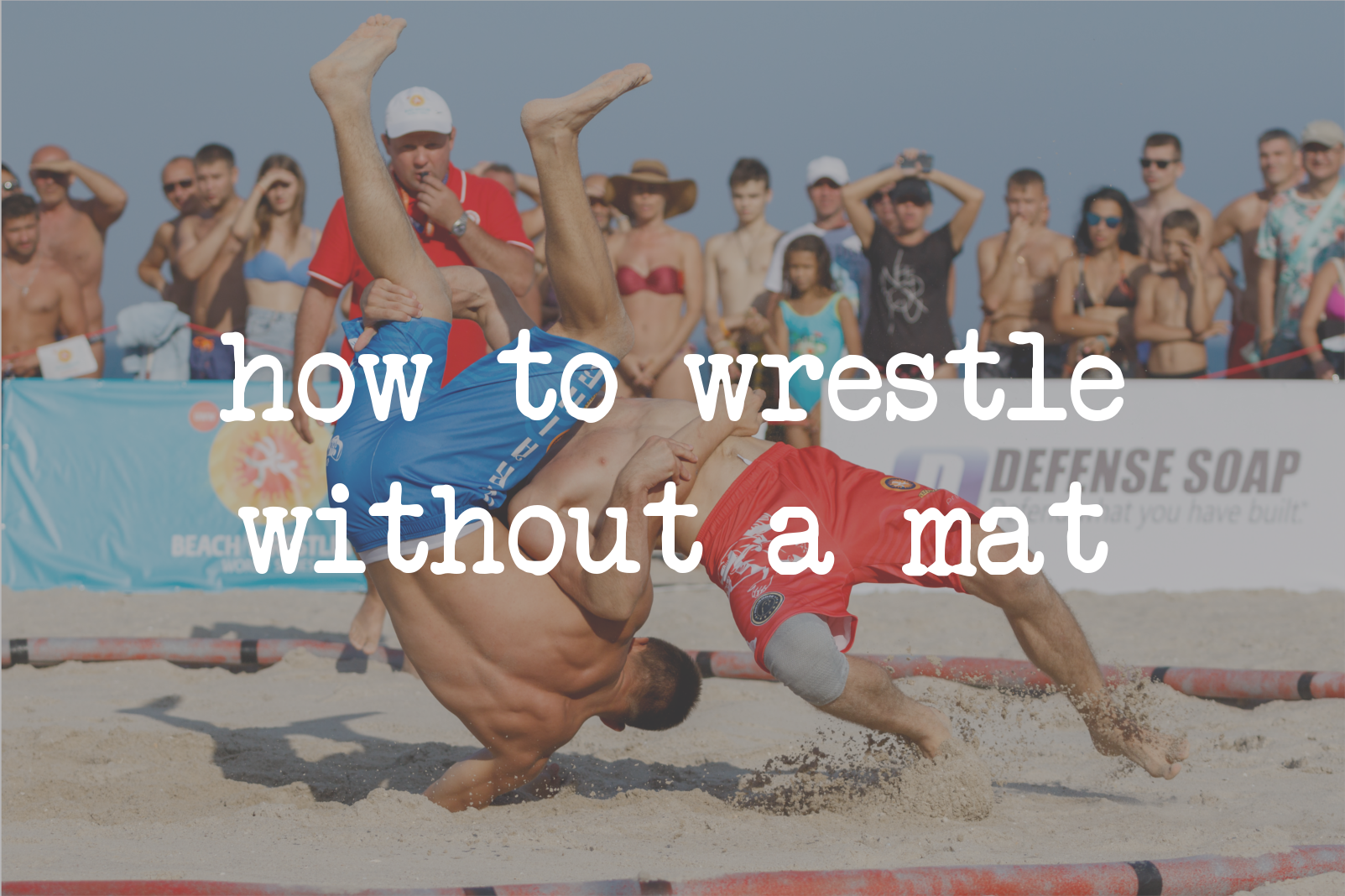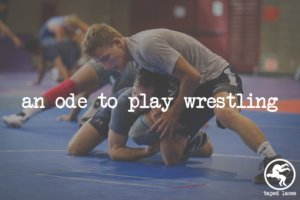One of the biggest challenges in increasing accessibility of wrestling is the requirement of a mat. Full-sized, and even home-sized 10’x10’ mats are expensive, so wrestlers are generally beholden to a school or club to provide them the time and space to practice. This makes it even more difficult to make wrestling a recreational activity, like pick-up basketball, for adults who aren’t a part of a team. Wrestling, however, takes many forms and can be practiced at home and on a variety of surfaces by simply utilizing a different ruleset. Here are a few different options that you can use to wrestle with no mat and with little to no required equipment.
Beach Wrestling

Beach wrestling is an official style sanctioned by United World Wrestling, and their regulations can be found here. Tournaments are becoming more and more common every year, now including 16U Nationals at Fargo and the intercontinental Beach Wrestling World Series. UWW has been focusing on expanding the reach of beach wrestling as they see an opportunity to bring a traditional form of wrestling that has taken place in countless cultures to non-traditional venues in beautiful destinations. It’s an innovative approach to attract a new audience and the ruleset seems designed to promote longevity and has a lower barrier of entry for athletes who are past their athletic primes. If no sanctioned tournaments are being held near you, matches are easy to set up on your own with only a rope. If no actual beaches are nearby, beach volleyball courts are a great option.
Gear Needed
- Rope or cord (72 feet in length)
- Open Beach
Surface(s)
- Beach
Rules
- The rope/cord is used to make a circle in the sand with a diameter of 7 meters (23 feet). This will serve as the out of bounds line.
- Wrestlers should be barefoot and wearing tight-fitting bathing suits.
- The match duration is one 3 minute period. All wrestling takes place in the neutral position and time only stops after a scoring sequence or for medical attention.
- Both wrestlers begin facing each other in the center of the circle and wrestling begins with the referee’s whistle. All restarts are performed in the same manner.
- 1 point shall be awarded to
- the wrestler who manages to bring any of his opponent’s body part to the ground, except the hands.
- the wrestler who manages to bring any of his opponent’s body part out of the competition area.
- the wrestler whose opponent has received a caution for illegal action.
Note: the attacker can put a knee (or any other body part) to the ground when executing an action if this action finished by the opponent in the ground.
- 3 points shall be awarded to the wrestler who manages to expose his opponent’s back to the ground during a takedown.
- The first athlete to 3 points wins the match. If they is a tie at the end of the match, the following criteria will be used to declare the winner:
- The highest value of holds
- Last point scored
- Lighter of the two wrestlers
- Illegal actions include:
- Holds causing dislocations
- Neck cranks
- Biting, punching, kicking, head butts, malicious cross faces
- Eye, ear, or nose gouging, fish hooking
- Pulling of hair, nose, ears, or attacking the groin
- Standing throws onto the head or neck (spikes)
- Coating the skin with any kind of greasy or slippery substance
- Stopping the match or leave the competition area for any reason
- Pretense of injury
Sumo Wrestling

Sumo wrestling is the national sport of Japan and is steeped in history. Its simplicity and lack of throws/takedowns make it a great form of wrestling to be practiced just about anywhere. All that is needed is a semi-soft surface and a circle to mark the boundary ring.
Gear Needed
- Rope or cord (47 feet)
Surface(s)
- Beach
- Soft Ground
Rules
- The rope/cord is used to make a circle in the sand with a diameter of 4.5 meters (15 feet). This will serve as the out of bounds line.
- Each wrestler enters the ring and faces each other in the center of the circle.
- Wrestling begins when each wrestler puts both of their hands on the ground.
- The objective of each wrestler is to force the other out of the ring or to touch any part of their body besides the soles of their feet to the ground. When either of these are accomplished, that wrestler shall be declared the winner
- There is no time limit or stoppage of the match (barring an injury) Wrestling shall continue until one wrestler is declared the winner.
- Illegal holds include closed-hand striking, kicking, choking, and hair-pulling.
Backhold Wrestling
Cumberland and Westmorland wrestling and Scottish Backhold wrestling are two branches of a family known as Backhold wrestling that were practiced in England and Scotland as early as the 7th century and are still competed in today. They were developed as safer alternatives to the violent Lancashire wrestling, which was also practiced in the UK, by eliminating ground wrestling. This makes backhold wrestling a great style to practice without a mat, as wrestling takes place entirely in the neutral position. The basic rulesets are nearly identical between the two styles and the simplified rules are outlined below.
Gear Needed
None
Surface(s)
- Beach
- Soft Ground
Rules
- Wrestlers stand chest to chest with their chins on their opponents right shoulder. Each wrestler places their right arm under the left arm of their opponent and locks their hands behind their opponent’s back.
- When both wrestlers have their locks secured, if a third person is present they give the order “wrestle” and wrestling begins. If no third person is present, one of the wrestlers gives the count “1..2..3..wrestle” and wrestling begins
- The objective for each wrestler is to get their opponent to either touch any part of their body besides their feet to the ground, or to break their hold. This can be accomplished through throws, trips, or any other means to unbalance the other.
- If any part of a wrestler’s body (knee, back, head, arm, etc.) touches the ground the bout is over, and the other wrestler is the victor.
- If either wrestler breaks their hold for any amount of time, the other wrestler is the winner.
- If both wrestlers fall to the ground at the same time, the wrestler to hit the ground last is the winner. If it is unclear who touched the ground first the bout is re-wrestled
Mongolian Bökh

Wrestling, known as Bökh, has been an important part of Mongolian culture since Gengis Khan’s reign in the 13th century, and still remains the most popular sport in the country. Matches take place on grass, have no time limit or weight classes, and the sole objective is to make your opponent touch the ground with any part of their body besides their feet. This makes it easy to do just about anywhere that you have a big enough patch of grass. There are many local variations, but the main ruleset practiced at the national Naadam festival is outlined below.
Gear Needed
None
Surface(s)
- Soft Ground
Rules
- Both wrestlers stand in an open field free of any rocks and debris. There are no out of bounds limits.
- Starting in the neutral position, wrestlers shake hands, get into a wrestling stance, then begin wrestling.
- Any wrestling hold, including grabbing the legs is allowed. Submissions and striking are not allowed.
- The objective is to get the other wrestler to touch the ground with any part of their body (hand, knee, back) besides the feet. The first wrestler to accomplish this is the winner.
- There is no time limit to the match. Wrestling continues until there is a winner.
Ankle Band Grab Wrestling
One of the concerns of wrestling without a mat is the impact that accompanies many takedowns. By changing the objective from completing a takedown to instead just getting a firm enough control of the lower leg to remove an ankle band, that concern is reduced, opening competition up to more surfaces. The concept is loosely derived from the toe-touch drill often done in wrestling practices, but requires more control of the leg to win.
Gear Needed
- 4 ankle bands
Surface(s)
- Beach
- Soft ground
Rules
- Each wrestler attaches an ankle band to each ankle.
- Starting in the neutral position, wrestlers shake hands, get into a wrestling stance, then begin wrestling.
- Acceptable wrestling holds and actions align with current UWW Freestyle rules.
- Each wrestler must try to pull the ankle band off of the other’s ankle. The band must be completely removed for the point to count.
- If a wrestler successfully removes a band, both wrestlers reset to the neutral position and wrestling begins again by smacking hands three times.
- The wrestler who successfully removes both bands from their competitor is the winner
Flag Football Belt Wrestling
This concept is very similar to Ankle Band Wrestling. Going from ankle bands to flag football belts shifts the objective from getting control of a leg to gaining more control of the upper body, while still not requiring a takedown to score.
Gear Needed
- 2 flag football belts
Surface(s)
- Beach
- Soft Ground
Rules
- Each wrestler attaches a flag football belt around their waist with just one flag hanging off of it. The flag should be positioned to be in the center of the wrestler’s back.
- Starting in the neutral position, wrestlers shake hands, get into a wrestling stance, then begin wrestling.
- Acceptable wrestling holds and actions align with current UWW Freestyle rules.
- Each wrestler must try to pull the flag off the other’s belt. The flag must be completely removed for the point to count.
- The wrestler who successfully removes the flag from their competitor’s belt is the winner.




